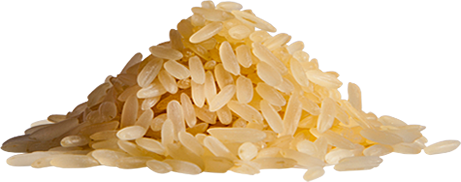RICE
Overview:
Rice is the seed of a swamp grass that is widely cultivated as a source of food for a large portion of the world's population. Worldwide, rice trails only corn in production. However, since a large portion of corn is grown for other than human consumption, rice is the leading crop utilized for human nutrition in the world. Rice is used as an entrée or a side dish; it also has applications as a breakfast cereal and a dessert. Rice is an additive in some pet foods and multi-grain breads. Oil extracted from rice grains is used both as a cooking oil and a cooking ingredient. Rice is also the key ingredient used in the brewing of sake.
Worldwide, there are more than 40,000 varieties of rice, each of which can be classified as long-, medium- or short-grain rice. The primary difference in each rice is its cooking characteristics and, to a lesser extent, subtle flavor differences.1
A series of processing steps are necessary to prepare harvested rice (referred to as "rough" or "paddy" rice) for consumption. The initial step is to separate the rice husk from the rice grain. This may be the only step in the progression for some rice as it creates "brown rice," which is valued as a health food product due to its high protein content. Otherwise, the rice is subjected to milling to remove the bran layer and then to polishing, where the surface of the rice is smoothed and given a shine by a series of rollers. After polishing, the rice is ready for packaging and delivery, either to a wholesaler or a processing facility.
Characteristics and Challenges:
Rice is free flowing, granular and may be mildly abrasive. Most grades of rice have an average bulk density of 45 lb/cu ft. 2
If the rice is being pneumatically conveyed into a processing system, the blower used to move the rice through the convey line must be sized to meet the demands of system. Rice can be degradable, so care must be taken to maintain an air-line velocity that does not damage the rice.
If the rice arrives at the processing facility in bulk bags, the frames used to discharge the bags should be equipped with additional accessories designed to reduce the amount of manpower and effort necessary to transfer the rice from the bulk bag into downstream equipment. These devices can elongate and
stretch the bags, which promotes a better flow and removes any pockets of rice cornered in the bags. Some of these bag activating devices also serve as dust tight seal between the bulk bag and the receiving hopper.
As the rice from the connected bulk bag fills the receiving hopper beneath it, the air inside the hopper is forced out. Unless this air passes through a filter, airborne dust particles can escape into the surrounding atmosphere. A dust collector mounted on the discharger frame will contain the dust inside the conveyance system, lowering the risk of a potentially dangerous dusting and reducing the time necessary to perform the routine cleaning and sanitation typically required in most food processing environments.
Feed hoppers should be designed with proper geometry and may need to incorporate devices such as vibrators to promote flow. If the rice is packaged in smaller bags, a bag dumping station with a dust hood and filtration devices may be sufficient to support the manual unloading of the material in hoppers. A bag compactor connected to the dumping station will permit operators to pass empty bags directly to a compactor, creating a dust-contained disposal method for the empty bags. A hopper screen above the receiving vessel will help to prevent the introduction of foreign objects and protects the operators from potentially dangerous conveying equipment.
If a flexible screw is being used to convey the rice, it is important to use a screw that matches rice's characteristics and other application requirements. Generally a round screw is necessary for moving rice up an incline.
As an additional precaution, some facilities employ the use of magnets and metal detectors during processing to remove any tramp metal objects concealed in the rice.
Should your rice application feature the loading the rice into bulk bags, the bag capacity will be maximized by use of a vibratory densification deck to level the rice as it fills the bag and by the application of load cells to achieve the desired weight. Seals and other dust containment devices will ensure a dust-tight operation.
Flexicon Applications:
Consultation with a Flexicon specialist will help you decide if a flexible screw or pneumatic solution best fits your rice application. Flexicon's expert design and engineering staff will weigh each parameter and recommend the best solution for you. Upon request, Flexicon's test lab will simulate your rice handling applications before the system is installed in your plant.
Flexicon's Dust Suppression and Collection Systems ensure proper containment of rice throughout the conveyance process. Flexicon's High Flow Hopper, purpose-built for flexible screw conveyors, increases the flow of both free- and non-free-flowing bulk materials while eliminating or decreasing the amount of residual material in the hopper as well as the need for flow promotion devices is perfectly suited for sugar handling.
Flexicon's product line of advanced flow promotion conveyors, high flow hoppers, deaeration/densification decks and a host of other components and accessories are proven performers that promote flow while reducing degradation, dusting and/or the separation of blends comprised of disparate particles.
As one example, see how Kennedy Rice, one of the largest growers in Louisiana, fills bulk bags with polished white rice using a Flexicon Model BFL-CFHW-X TWIN-CENTERPOST™ Bulk Bag Filler.
Related Articles on Rice:
1 American Rice Inc.
2 Powder & Bulk.com Bulk Density Chart
Sources: Where noted. All other information courtesy of Flexicon Corporation.